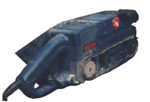
$130 upwards
Belt sanders are used to remove large amounts of wood in order to roughly sand the wood to shape. For example, if the wood in question has small ridges in it, a belt sander can be used to flatten these out. An extreme case of how the belt sander can be used to shape wood can be seen in the June 1997 issue when a belt sander was used to round off the front of the bedside cabinets into a smooth curve.
It is important to note that a belt sander is an intermediate step in the finishing process. Once you have roughly sanded the wood to shape with the belt sander you will still need to use an orbital or palm grip sander to get a smooth finish.
It is worth considering the following when purchasing a belt sander:
If misused, belt sanders can cause serious injuries. While this is true for most power tools, we feel that it worth stating explicitly here. Many people do not think that belt sanders can cause injury because their experience has been with orbital sanders. Nothing could be further from the truth. Belt sanders use very coarse sand paper at high speeds and will easier tear through your skin. These sanders should therefore be treated with the same caution and respect as a circular saw.
To use the belt sander, first hold the sander away from the work and start the motor. Once the sander has reached its full speed, lower it onto the work with a slight forward motion. The main handle (at the back) is used to control the sander while the front auxiliary handle is used to guide it. When placing the sander on the work, let the rear roller make contact first, bringing the rest of the base into contact with the work as you begin to move the sander forwards.
The sander should be moved back and forth parallel to the grain of the wood. Do not let the sander stay in one place as this will cause an uneven surface. Short, overlapping strokes produce the best results. Avoid tilting the sander sideways as the belt edge can easily cut into the wood. Further, do not apply excessive pressure to the sander; the weight of the sander is usually enough to efficiently sand the wood. Use a coarse grit belt for most of the sanding, followed by a finer grit and then finish off by using an orbital or palm grip sander.
Never change a sanding belt when the belt sander is still plugged in.